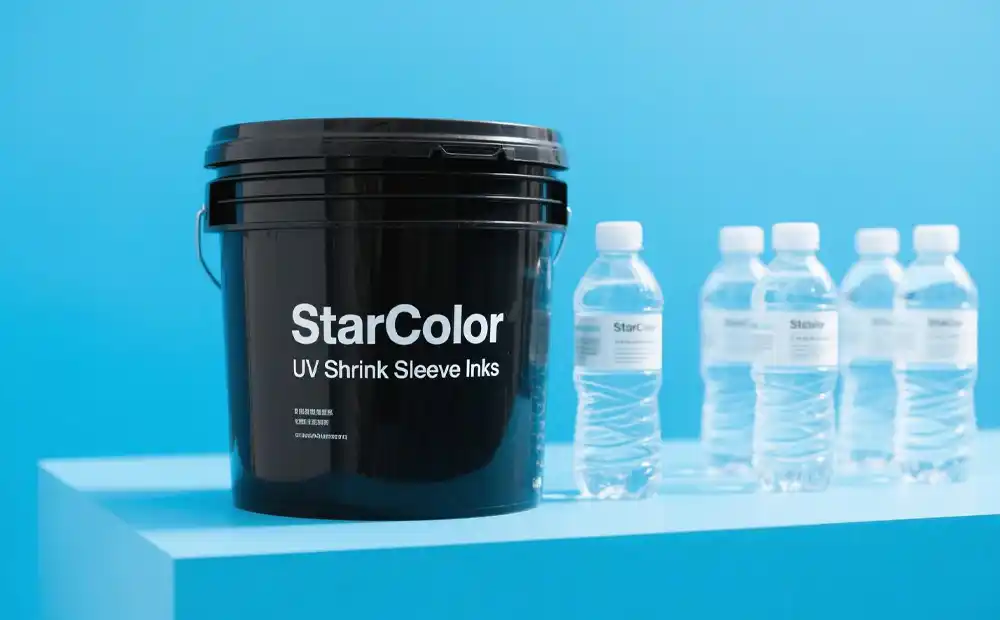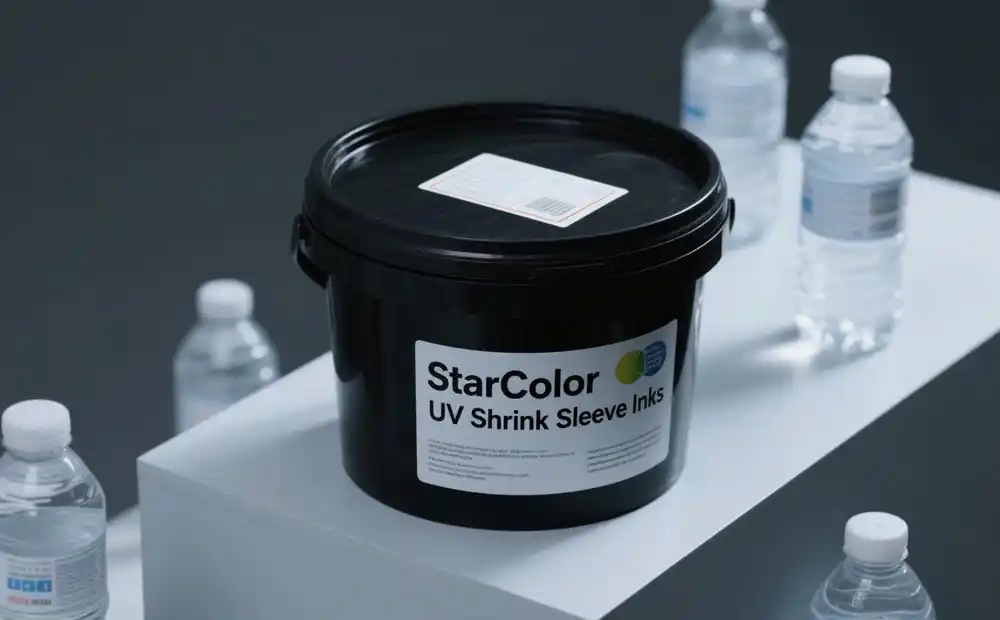Precautions for UV Ink Printing Heat Shrink Film
Date: Jun 20 2025 From: Star Color Views:
Heat shrink films have gained increasing favor among brand owners due to their excellent visual coverage and fitting performance. Using UV inks for printing on heat shrink films can achieve higher image clarity, faster production efficiency, and stronger adhesion. To achieve high-quality printing effects on heat shrink films, in addition to selecting suitable ink suppliers, it is essential to precisely control the technical key points throughout the production process. Based on over 10 years of experience in the printing industry, the author shares the critical technical details and quality control methods for using UV inks to print common heat shrink films such as POF, PVC, PET, and PE, providing references for industry practitioners.
UV Ink Formula Selection Based on Material Properties
The material properties of heat shrink films significantly affect ink adhesion and shrinkage performance. POF (polyolefin) films are environmentally friendly and have high shrinkage rates but low surface polarity; PVC (polyvinyl chloride) films offer good flexibility and relatively high surface energy; PET (polyethylene terephthalate) films excel in transparency and mechanical strength, requiring strict ink heat resistance; PE (polyethylene) films are known for their good chemical stability. The surface energy of these materials ranges from 34-36 dynes for POF to 38-42 dynes for PET, leading to different wetting, spreading, and adhesion performances of inks on various substrates.
Key performance indicators for selecting UV inks include:
- High flexibility: During heat shrinkage, the film undergoes deformation of 15%-75%, and the ink must have an elongation at break ≥50% to ensure the pattern remains intact after shrinkage. For example, StarColor's special Shrink Sleeve UV ink series uses elastic polyurethane prepolymers combined with flexible monomers to maintain the pattern without cracking at a 70% shrinkage rate.
- Broad-spectrum adhesion: Introducing resins with polar groups such as hydroxyl and carboxyl groups enhances the interfacial force between the ink and different substrates. Verified by the ASTM D3359 cross-cut test, high-quality UV inks can achieve a 5B-level adhesion on POF, PVC, PET, and PE films.
- Shrinkage stability: Using pigment dispersion technology and a photoinitiator synergistic system ensures that the ink color ΔE≤2 at the shrinkage temperature of 120-160°C, avoiding hue shift.
- Comprehensive resistance: Heat resistance should withstand 160°C×30s without discoloration or blistering; scratch resistance should meet the 3H pencil hardness test standard to satisfy transportation and shelf display requirements.

Refined Management of Surface Treatment and Tension Control
(一)Optimization of Corona Treatment Technology
Corona treatment enhances surface energy by generating free radicals on the film surface to initiate oxidation reactions. Different materials respond differently to corona treatment:
- POF films are recommended to be treated at an intensity of 38-40 dynes, with an unevenness controlled within ±1.5 dynes to avoid local ink dropout.
- Due to its high crystallinity, PET film requires a surface energy of over 42 dynes, which can be achieved by using double-sided corona treatment combined with silane coupling agent pretreatment.
Printing should be completed within 24 hours after corona treatment to avoid natural decay of surface energy. Regularly detect with a dyne pen and conduct quantitative analysis with a contact angle tester to ensure stable treatment effects.
(二)Static Electricity and Dust Control
Films are prone to static electricity during production and transportation, attracting dust and impurities, which cause printing defects such as white spots and pinholes. The following measures can be taken:
- Install ion bars or static eliminators to reduce surface static voltage to below ±100V.
- Maintain the printing workshop cleanliness at ISO 8 class standard, using dust curtains and air filtration systems to reduce environmental dust.
- Perform dust removal on the film before unwinding, using sticky rollers or static dust removal equipment to remove surface impurities.
Precision Control Technology for Ink Thickness
The drying characteristics of UV inks make thick ink layers prone to quality issues. During shrinkage, stress concentrates within the ink layer, and the risk of cracking increases significantly when the thickness exceeds 12μm. Precise control can be achieved through the following technical means:
- Anilox roll parameter optimization: Select appropriate line counts based on pattern complexity and ink transfer requirements, such as 300-400 lines for solid color blocks and 400-500 lines for fine graphics. Meanwhile, match the anilox roll volume with blade pressure, and it is recommended to use ceramic anilox rolls to improve ink transfer uniformity.
- Multicolor overprinting process optimization: Use trap technology to reduce ink layer thickness in overlapping areas, and set a 0.1-0.3mm overprint compensation between adjacent color plates. For gradient patterns, frequency modulation screening technology can be adopted to reduce the risk of ink accumulation.
- Online detection system: Install online detection equipment such as densitometers and film thickness gauges to real-time monitor changes in ink thickness and density, and automatically alarm and adjust when the ink layer thickness fluctuates by more than ±1.5μm.
Precise Regulation of UV Curing Process
The UV curing process requires a balance between ink crosslinking degree and flexibility. Over-curing increases the ink's glass transition temperature, making it prone to cracking during shrinkage; under-curing affects adhesion and wear resistance. Key control points include:
- Light source selection and parameter setting: Medium-pressure mercury lamps are recommended, with a main emission wavelength of 365nm and a power density of 80-120W/cm. Adjust the distance between the lamp and the recommended 10-15cm and irradiation time to control UV energy at 120-200mJ/cm².
- Speed-power collaborative control: Establish a corresponding curve between speed and power. For example, when the printing speed is 20m/min, set the UV power to 80%; when the speed increases to 30m/min, adjust the power to 100% to ensure sufficient and non-overexposed curing.
- Cooling system configuration: Use air or water cooling devices to control the film surface temperature below 45°C, avoiding premature shrinkage or deformation of the film due to heat conduction. Regularly detect lamp energy decay and replace the lamp in time when the energy drops by more than 20%.

Simulation Testing and Process Optimization of Heat Shrinkage Performance
The heat shrinkage process is the ultimate test of ink performance. Different films have significantly different shrinkage characteristics: POF films start to shrink at 80-120°C, while PET films require high temperatures of 150-160°C. To ensure ink and film compatibility, the following tests should be conducted:
- Simulated shrinkage test: Use a laboratory heat shrinkage oven to set stepwise temperatures (e.g., 120°C, 140°C, 160°C) and times (3-10s), and observe ink cracking, powdering, and color changes. Use a digital microscope (100-500x magnification) to detect micro-cracks and quantitatively evaluate performance.
- Curved part test: For special-shaped parts such as bottle mouths and shoulders, make special molds for local shrinkage testing. Optimize graphic design to avoid large solid color areas, and use dot transition or hollow design to disperse stress.
- Accelerated aging test: Place the shrunk samples in a constant temperature and humidity chamber (60°C/90% RH) for 48 hours to evaluate the ink's resistance to heat and humidity and ensure long-term storage stability.
Storage and Environmental Control Standards
The storage and use environment of UV inks are crucial to printing quality:
- Ink storage management: Use light-shielded sealed containers, control storage temperature at 15-25°C, and avoid premature decomposition of photoinitiators in the ink. Unused ink should be protected with nitrogen to prevent oxidation and deterioration.
- Workshop environment control: Maintain temperature at 18-28°C and relative humidity at 40-60% to reduce ink viscosity fluctuations and moisture absorption. Regularly clean equipment and use special cleaning agents to remove residual ink in the ink path system to avoid crusting and blockage.
- Static electricity protection: Operators should wear anti-static clothing and wrist straps, and the equipment grounding resistance should be ≤10Ω to prevent the impact of electrostatic discharge on ink performance.
Conclusion
UV ink printing on heat shrink films is a complex process system with multi-parameter coupling. From ink selection and surface treatment to shrinkage forming, minor deviations in each link may lead to quality defects. Industry practitioners need to establish a systematic quality control system, combined with online detection, simulation testing, and process optimization, to continuously improve printing quality.
As a professional supplier in the field of heat shrink film printing inks, StarColor can provide customers with full-process solutions from ink customization and process debugging to technical training, helping enterprises achieve efficient and stable production goals.
Welcome to contact us for professional technical support and sample testing services.
 RU
RU
 EN
EN
 CN
CN


